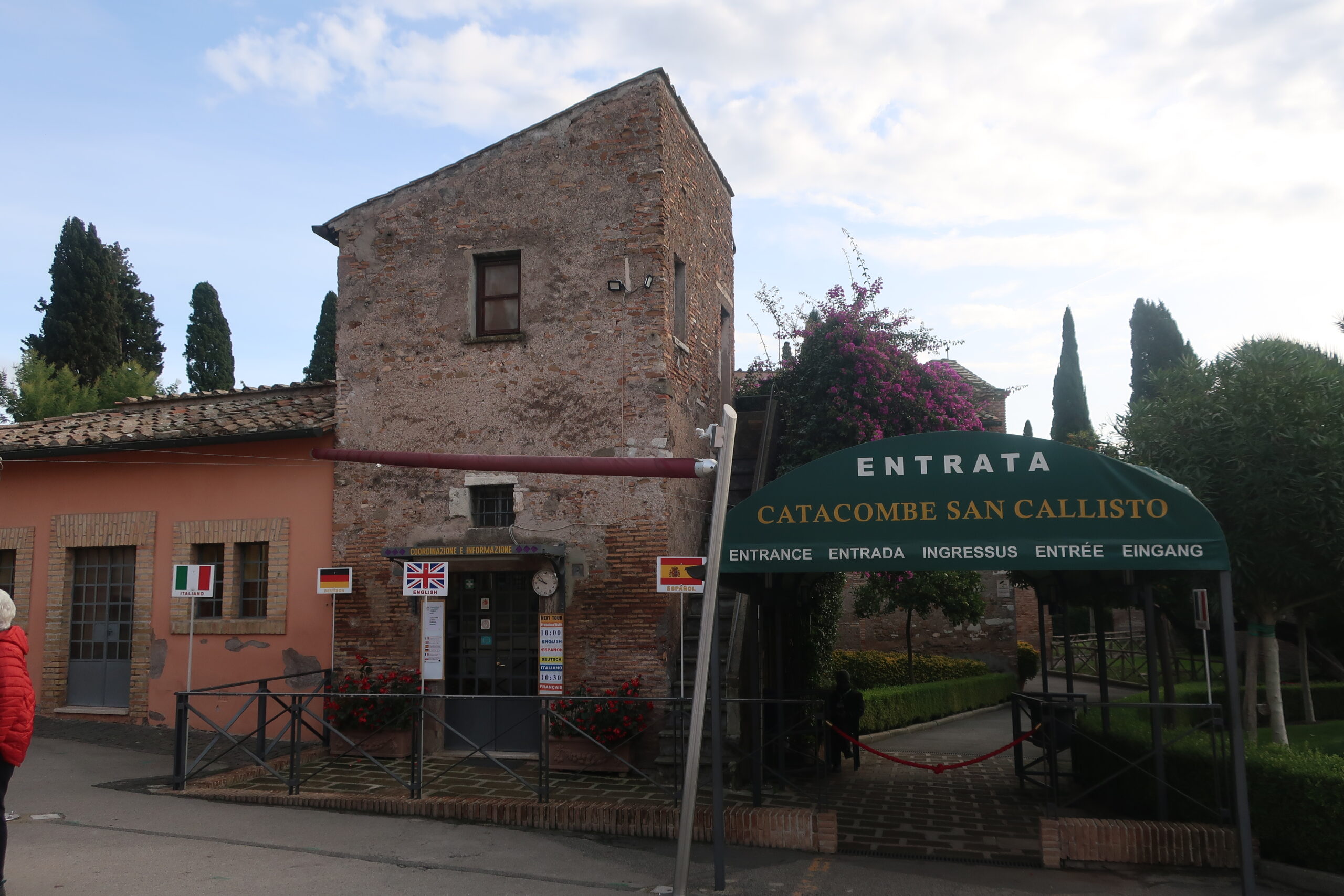Table of Contents
Travelogue of Rome] (10) Visiting the Catacombs of San Callisto - Considering the History of Catacombs and Rome as a City of Death and Prayer
The existence of "tombs" is still significant when considering the Christian city of Rome.
St. Peter's Basilica also began as the tomb of St. Peter.
The city of Rome has a history of development centering on tombs. In this article, we would like to consider Rome, the "City of Tombs.
Rome, the City of Tombs
In his book "The Tombs of the Popes," Gregorovius describes his research in Rome as follows: "In Rome, more than in any other city in the world, research leads us in the footsteps of death. In Rome, more than in any other city in the world, the study leads us to the footsteps of death. And nowhere on earth does melancholy strike the heart of man more than in this eternal Rome, where Nemesis, the avenging goddess of history, lies beautiful and sad beneath the ruins of centuries of history. In other words, Rome is full of memories of death.
Shelley also sang of Rome as "a heaven and a tomb, a city and a wilderness. In fact, Rome is the city of the grave. Christianity is also a "religion of death" and a "religion of victory over death. It is impossible to walk around Rome and tour the city without stepping on the tombs inlaid into the floor of the cathedral, or seeing the skeletons of saints dressed and enshrined under the altar, or the paintings depicting the deaths of martyrs as if they were intercessors. History is a record of the dead, and this may be unavoidable, but in no other city is death so much a part of life and the city as it is in Rome. Anthropologists say that death is a modern taboo. In this sense, Rome, and especially the Roman cathedrals, may be said to be a challenge to us.
Masumi Ishinabe, Yoshikawa KobunkanAs Long as St. Peter's Stands: My Guide to Rome.p147-148
*some line breaks.
Rome is filled with memories of death."
In fact, Rome is the city of the tomb. And Christianity, too, is a 'religion of death,' a 'religion of triumph over death.'"
When we think of Rome, we tend to focus on the temple of beauty and the romance of ancient Rome, but when you look at it this way, you can see that it is indeed true. Rome was also a city of tombs and death.
History of Tombs in Rome
Now, the tomb also appears in the drama of the birth of Christian Rome that captured Gibbon and Gregorovius. Needless to say. It is the catacombe. This Christian catacombe, built from the height of the empire to the end of the empire, is the overture, so to speak, of the drama of the birth of Christian Rome.
But before seeing them, it would be better to see the tombs of the Romans of that time, that is, the pagans. To do so, it is worth visiting the tombs of the Scipio family and of Pomponius Hulas, located on the Appian Way, just before the San Sebastiano Gate. Of these, I find particularly interesting the columbarium (colombario), an ancient communal cemetery discovered near the tomb of Scipio. As the name suggests, the four walls are lined with semi-circular niches, like pigeon houses, and each niche has two urns in it. It looks like an ancient-style tomb apartment. The columbarium is a type of cemetery found only in Rome and Campania, and was built by individuals for the benefit of their families, for profit from the sale of lots, or by mutual aid societies for their members. In ancient Rome, both cremation and burial were legal, but since the Republican period, cremation, as in this columbarium, has been the norm. In contrast, it was not until the second century that the use of sarcophagi instead of cremation became popular.
Such tombs were all located outside the city walls, as it was strictly forbidden to build them inside the city (the tombs of the Scipio family, as mentioned above, were also outside the city walls during the Republican period). Ancient Rome was also a city surrounded by countless cemeteries. They called such cemeteries necropolis, or cities of the dead, according to Greek tradition. The Christians, on the other hand, used the term cumiterium, or domitorium, to refer to their cemeteries. For them, the tomb was merely a place to sleep until the day of the resurrection.
Masumi Ishinabe, Yoshikawa KobunkanAs Long as St. Peter's Stands: My Guide to Rome.p148-149
As a monk, the history of tombs and burials is indeed interesting to me. I was also surprised to learn that cremation was once practiced in Rome.
And out of this cultural background, Christian catacombs are born.
The Beginning of the Catacombs
It is said that Christians, who did not have special cemeteries in the beginning, began to build their own underground cemeteries called catacombs around the beginning of the second century. This started when a wealthy believer buried a poor fellow believer in his family's tomb. This is why many catacombs, like Domitilla and Priscilla, are still referred to today by the name of the first grave owner or land donor.
Christians chose the catacombe form of underground cemetery because their burial method was earth burial. In other words, while burial in the ground would require a large area of land, underground burial would require digging down as far as necessary, thus making it possible to build a tomb close to the city at a low cost. In addition, it would have been more appropriate for them to be underground, where they could gather with their friends after their death and quietly await the day of their resurrection. Also, since many martyrs were buried in Catacombe, the believers wanted to build a tomb near it to ensure their own salvation. This is why the catacombs developed so much. In the third and fourth centuries, catacombs came to be owned or controlled by the church and were systematically built.
Masumi Ishinabe, Yoshikawa KobunkanAs Long as St. Peter's Stands: My Guide to Rome.p149-150
Catacombs began to be built in the 2nd century.
It began with the practical aspect of building a tomb near a city at a low cost.
Catacombs of San Callisto on the Appian Way
Today, about sixty catacombs have been discovered in the vicinity of Rome. Of these, only about 10% are open to the public, but three of the most important and large catacombs, San Callisto, San Sebastiano, and Santa Domitilla, located along the Appian Way and the Ardeatina Road, are visited by many people as pilgrimage sites and as places for tourists to see. The three catacombs of San Calisto, San Sebastiano and Santa Domitilla are visited by many people, both as pilgrimage sites and as tourist destinations. In addition, the Basilica of San Lorenzo and the Basilica of San Tañese also have catacombs that are not very large, but still retain their original rustic appearance. The Priscilla Catacombe along the Salaria Road is also worthy of special mention, both for its wonderful wall paintings and for its unique, non-touristy atmosphere. In many ways, each of these catacombs is worth a visit. It is a "must" for any visitor to Rome to spend at least half a day enjoying the refreshing atmosphere of the Appian Way and visiting one or two of the catacombs along the way.
All of these catacombs are to be visited by a guide. The catacombs are a veritable underworld, a veritable underground labyrinth. In catacombs like Santa Domitilla and San Callisto, which have been excavated for over 300 years, the galleries (subterranean passages) extend over 20 kilometers and are excavated in three or four layers. So much so that even Antonio Bosio, who discovered 30 catacombs at the end of the 16th century and is known as the "Columbus of the Roman Underground," got lost in the catacombs of Santa Domitilla and wandered around in the dark in search of a way out. Needless to say, it is impossible to visit without a guide.
The Roman catacombs were built of tufo, a type of rock known in the local language as "capellacci," which crumbles when touched by hand. The tufo was ideal for catacombs because it was easy to dig and drained well. In addition to historical and social factors, these natural conditions contributed to the development of catacombs in Rome.
The first layer of the catacombs is 3 to 8 meters below the ground, the second layer is 10 to 15 meters, and the third layer reaches up to 20 meters. Some catacombs in San Callisto reach as high as 25 meters underground. As we proceeded through the gallery, where darkness and silence reigned, with its many levels of grave pits, called loculi, on both sides, we wondered what had inspired the early Christians to build such underground cemeteries. Catacombs were built in increasing numbers as Christianity was recognized and the number of believers grew. The catacombs were dug for two or three centuries, until the Gothic sack of the city in the early 5th century led to the construction of an above-ground cemetery in a safe location within the city walls.
Masumi Ishinabe, Yoshikawa KobunkanAs Long as St. Peter's Stands: My Guide to Rome.p150-151
In many ways, each of these catacombs is worth a visit. At the very least, it is a 'must' for any visitor to Rome to spend half a day enjoying the refreshing atmosphere of the Appian Way and visiting one or two of the catacombs along the way."I decided to visit the catacombs of San Callisto as Masumi Ishinabe had mentioned.
I visited these catacombs along with a tour of the Appian Way and the Claudia Aqueduct.

This is the entrance to the Catacombs of San Callisto. From here, you enter the basement from the building ahead. Photography is of course prohibited inside the catacombs.
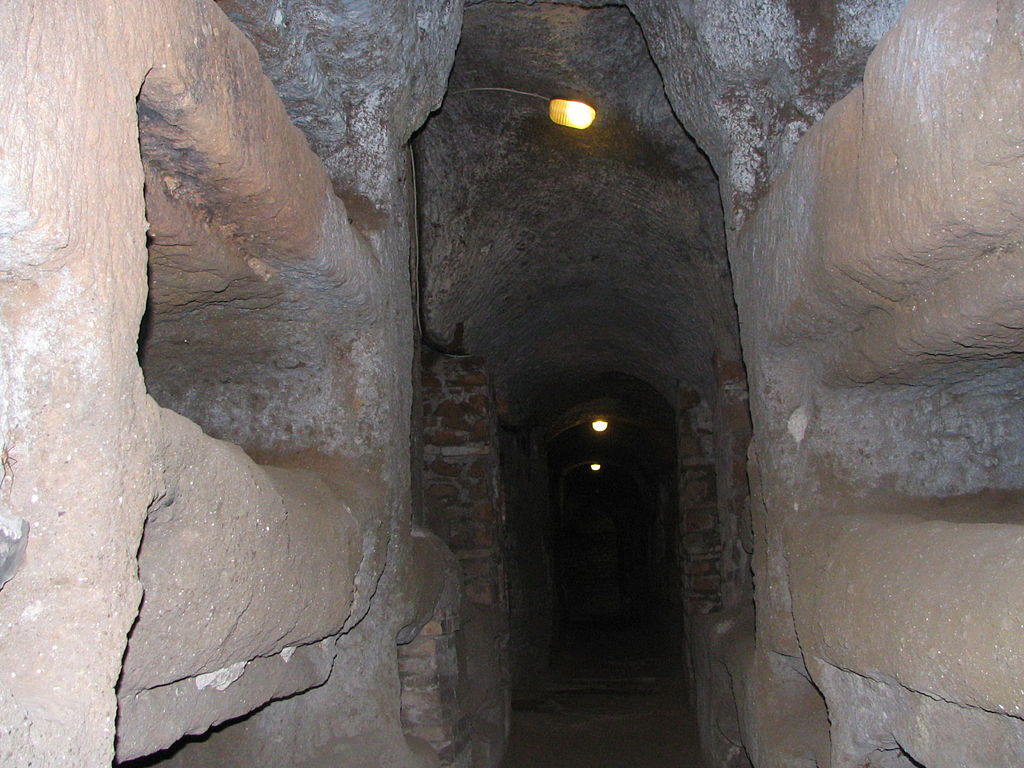
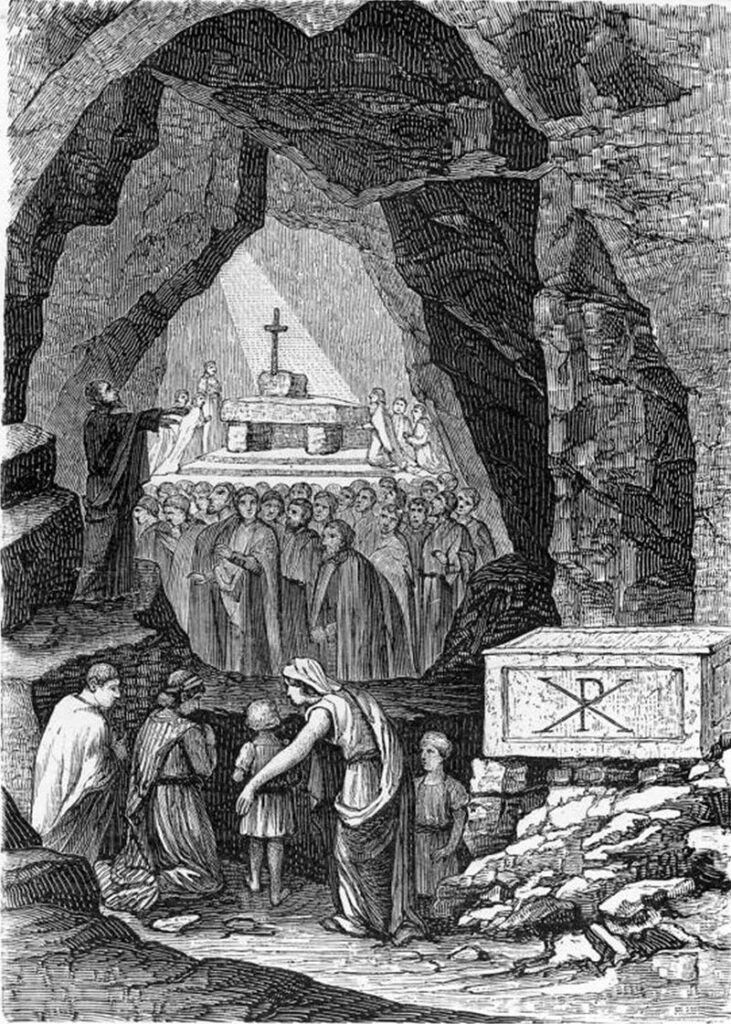
I followed the guide as we walked through the catacombs. As mentioned in the commentary above, even though the soil is soft and easy to dig, I was surprised at the enthusiasm of the people who dug so deep into the ground. The passageways are lit now, but back then it would have been pitch black. Even if firelight was used, there was a limit. It is amazing that they built such deep and labyrinthine catacombs in such a situation.
If I were left alone in a place like this with no light, I would be scared out of my wits.
The tour of the catacombs did not take us as deep underground as I had imagined. However, in some places we could see the darkness on the other side of the passageway, which led us to imagine the abyss beyond. The labyrinthine nature of the catacombs is reminiscent of Andersen'sThe Improvising Poet.But it is interesting that the dark horror is portrayed in a very realistic manner. I highly recommend "The Improvised Poet" when you come to Rome.
And in the middle of these catacombs, we saw one famous grave.
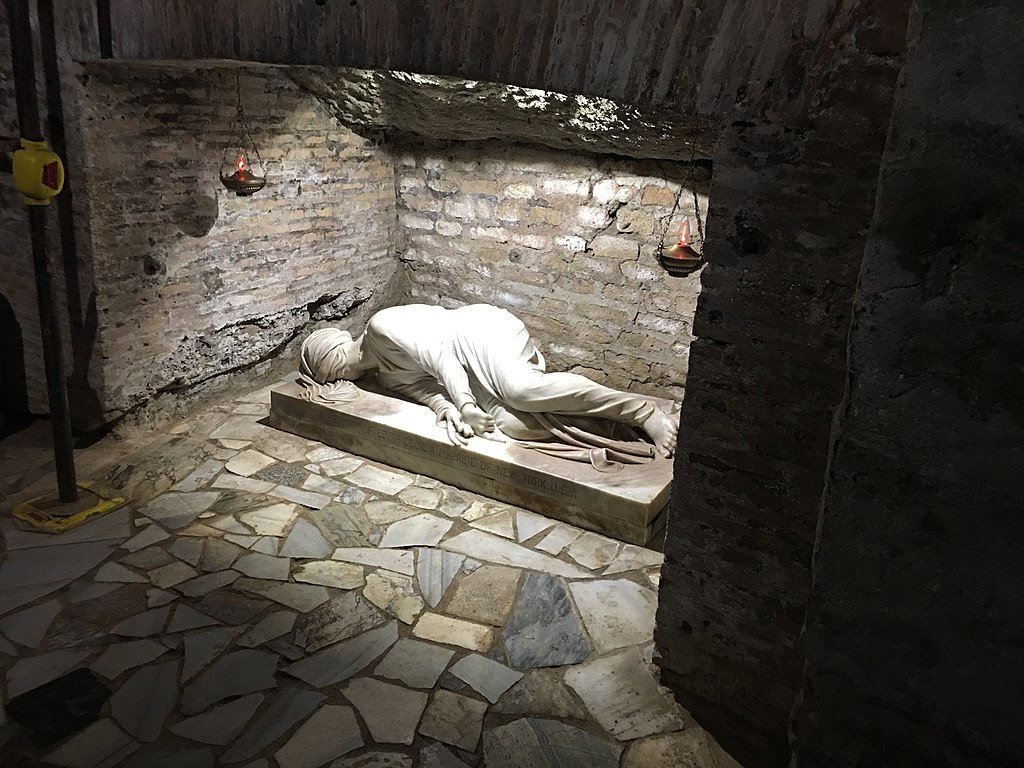
This is the tomb of St. Cecilia. St. Cecilia (Santa Cecilia) was a martyr of the Roman Empire around the second century, famous as the patron saint of musicians and the blind. Her tomb was located in the catacombs of San Callisto. Incidentally, the sculpture in this photo is a replica of one made by Stefano Maderno in 1600. The original was made in Rome.church of santa cecilia in trastevereIt is housed in a
And this St. Cecilia is also famous for Raphael's painting. This "Santa Cecilia," which is in the collection of the Bologna Picture Gallery, is also known to have been a favorite of Russian literary giant Dostoevsky (for more information, see(23) Visiting Venice, a colorful city of art: What did Dostoevsky think of this beautiful city of water?(See article on)
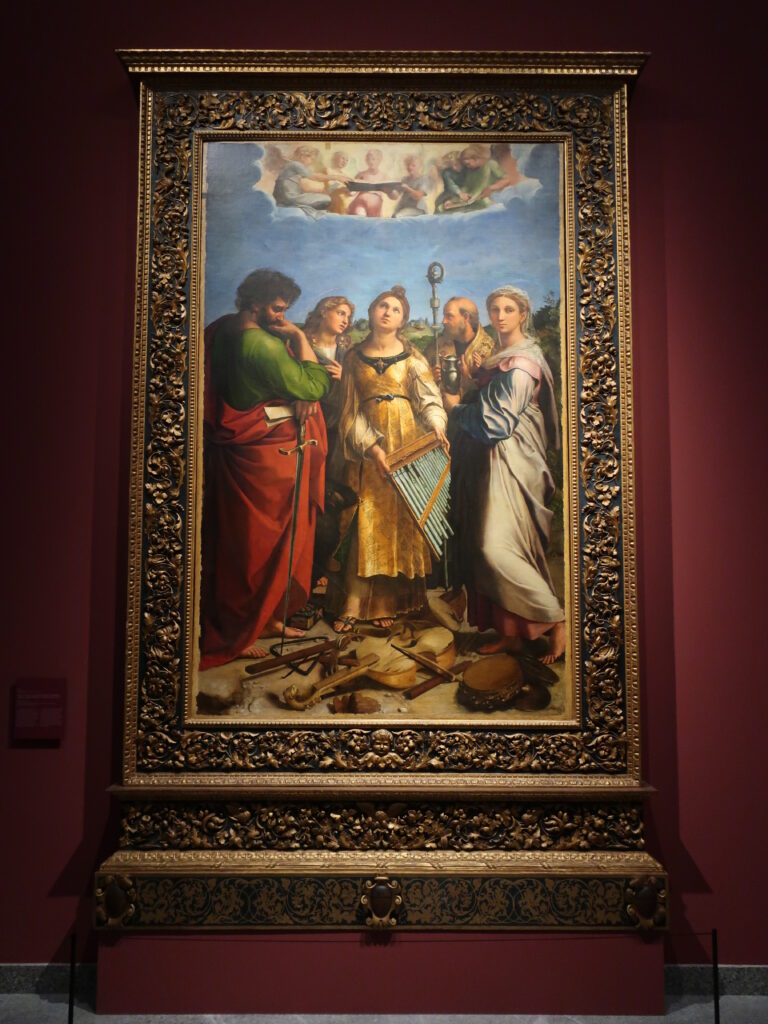
As the patron saint of music, this painting depicts a musical instrument. However, the composition of the patron saint of music is very strange, with a broken instrument placed carelessly. The depiction of the faces, poses, and clothing of each of the figures is unmistakably Raphael-like. Dostoevsky, an unparalleled Raphael lover, must have found this work to his liking.
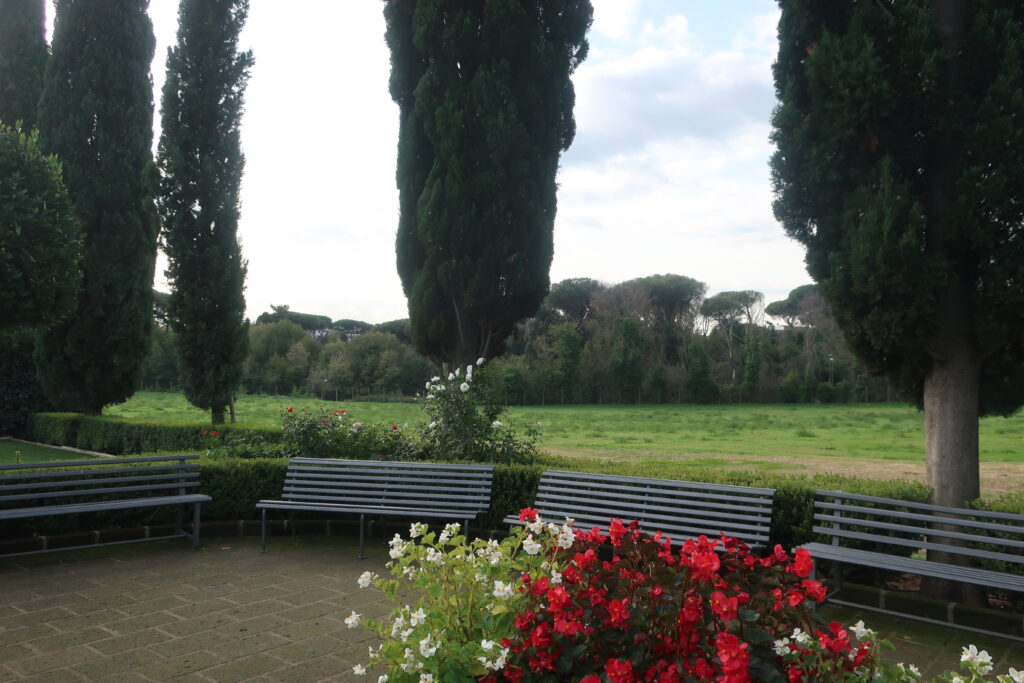
We are back on the ground from the catacombs. Underneath this field is the catacombs. If you look at this place without knowing anything about it, it is just an ordinary meadow. However, this is not the case once you know the history of the catacombs. Not only the catacombs, but also the city of Rome itself is closely connected to death. And Christianity has preached "death and resurrection. Perhaps this is the key to why Rome and the Vatican attract so many people.
It is true that today, death is taboo and we try to keep it away. The scene of death is cut off from our daily lives. But is this really a good thing? Death is the reason for our life. Death and life are one and the same. To keep death away from us is to keep even our life away from us.
We live as beings who will surely die. And we are living a life in which we are also sent off at the end, having seen off countless deaths. Living with death is the wisdom of human beings. It is because we are so close to death that we have been able to live more deeply. Of course, there is sorrow. There is suffering. But even so, I cannot help but feel a sense of concern for a world that keeps death at a distance. I believe that people today have lost their sense of life and death. All we have is "life and death" as individuals. When we die, it is the end. Nothing. The rest is just the field and the mountains. I do not intend to deny this way of thinking. However, I am afraid of what will happen if the world is populated only with people who think in this way.
"You want me to have a life-and-death philosophy for the sake of stability in the world?"
There may be such criticism.
However, I believe that the view of life and death is important not only in the social aspect but also in the individual life. Those who believe that "when you die, you are nothing" are living such a life. They live their lives thinking, "I'll be nothing when I die anyway. It could be said that they are influenced by "death" to a great extent.
And if we are nothing when we die, what are we living for in the first place?
In fact, I had a raging fear of death during the course of this trip. It wasn't that I was in any particular danger or anything. It happened the moment I saw the advertising poster I saw on the train.
I have a weakness for dolls and stuffed animals. I have a weakness for dolls and stuffed animals. The poster was a picture of a man about 30 years old sitting alone in a room holding a stuffed bear the size of a human being. For some reason, I was intensely scared when I saw it.
Emptiness. If I die, what will be left? Will everything I am doing now and everything I am going to do in the future eventually come to nothing? If that is the case, what is the point of me now?
Everything comes to nothing. Everything is meaningless. If I die, emptiness awaits me... I suddenly felt the horror of it.
I froze in the train. I had come to Europe after all this preparation and hard work. I had come here as the culmination of my life. I had come here with determination. But what if it was all for nothing? If the destination is emptiness after all... I was struck by this fear. More than death itself, it was the fear of emptiness.
Isn't it too horrible to be "nothing when you die?" How can people in the world endure it? Can they say that even when death is right in front of them?
I had such a thought.
Why must I live and die? Can I put it all away with "nothing when I die"? Unfortunately, I cannot.
Ultimately, life may have no meaning. We just live and we just die.
However, there may be times when one still pursues it and is saved by it and lives powerfully to the end.
I think so. No, I would like to think so.
The story may have gotten a bit long, but the visit to the catacombs reminded us that Rome is not only a temple of beauty, but also a "city of tombs" and a "Rome of death and prayer.
be unbroken
*The list of articles in the "Rome Travel Journal" can be found atCategory page hereindicates direction or goal (e.g. "to")
*Please visit this category page for recommended books to learn about Rome and Italy.
The Rise and Fall of the Roman Empire, the Vatican, and Roman Catholicism."
The Italian Renaissance and the Revolution in Knowledge."
Next Article.
Click here to read the previous article.
Related Articles











